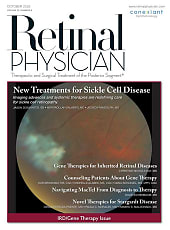Ligneous conjunctivitis is the most common clinical manifestation of plasminogen deficiency type 1 (PLGD-1), with 81% of patients presenting with ocular involvement. PLGD-1 is a systemic protein deficiency characterized by the formation of ligneous lesions on mucosal membranes throughout the body. The lesions are often inflamed and painful and, if left untreated, can lead to organ dysfunction and failure, including vision impairment and blindness.1 With the FDA approval of RYPLAZIM (plasminogen, human-tvmh; Kedrion Biopharma, Inc.), there is now an effective treatment for PLGD-1.2
Here, we follow the journey of a patient with PLGD-1, along with general insights on this disorder from Angela Y. Zhu, MD.
Manifestation
A 51-year-old female patient first showed manifestations of plasminogen deficiency type 1 (PLGD-1) during her infancy. At 6 weeks of age, she presented with eyelid lesions, diagnosed as ligneous conjunctivitis by an ophthalmologist. Recurrent ear infections followed at age 4.
By age 14, she had developed sinus issues, pharyngitis, and reproductive tract complications, and at age 18, gingival lesions appeared. The patient underwent multiple surgical excisions of eyelid and gingival membranes; however, the lesions consistently recurred. During this time, no connection had been made yet between the patient’s symptoms and PLGD-1.
Diagnosis
At age 22, the patient underwent plasminogen level testing at the recommendation of a dentist. More than 2 decades after her initial diagnosis of ligneous conjunctivitis, test results confirmed systemic PLGD-1. The patient was referred to a hematologist.
Treatment
At the time of the patient’s PLGD-1 diagnosis, there was no FDA-approved treatment for PLGD-1. At age 32, she began instilling allogenic fresh frozen plasma eye drops, which helped manage her eyelid lesions but did not address manifestations affecting the auricular structures, oral cavity, nasal cavity, or reproductive system.
In 2023, at age 49, systemic treatment with RYPLAZIM—a plasma-derived plasminogen concentrate that increases circulating plasminogen levels—was initiated. Within 30 minutes of the infusion, the patient reported symptomatic improvement in her eyelids and nasal cavity. RYPLAZIM enables the resolution or reduction of fibrin-rich lesions affecting mucous membranes throughout the body due to PLGD-1.4
Outcomes
Now age 51, the patient receives RYPLAZIM on a regular basis to maintain higher plasminogen levels and prevent symptom recurrence. The patient’s vision and systemic symptoms are all stable and well-controlled without a recurrence of lesions. The patient describes the infusion therapy schedule as manageable and allows her to lead a normal life, including travel and remote work.
Insights into PLGD-1
By Angela Y. Zhu, MD
This patient’s journey illustrates several significant points about ligneous conjunctivitis and its relationship to PLGD-1.
Ligneous conjunctivitis may occur at any age but generally presents during childhood. The recurrent, eponymous “woody” pseudomembranous lesions of the tarsal conjunctiva are often the earliest visible manifestation of PLGD-1. In fact, one-third of patients with PLGD-1 may develop corneal involvement with potential for vision impairment.1
Persistent pseudomembranous conjunctivitis, especially when accompanied by lesions in the gingiva or other mucosal sites, is strongly suggestive of PLGD-1 and warrants laboratory confirmation of plasminogen activity. Communication with other members of the patient’s care team can help ensure appropriate systemic diagnosis and management steps.
Although prompt surgical excision may be necessary to prevent more serious complications—e.g., blindness, tooth loss—recurrence is nearly universal without addressing the underlying plasminogen deficiency. With RYPLAZIM, we now have an FDA-approved treatment for PLGD-1 that resolves recurring lesions and prevents new lesions.3
References
- Shapiro AD, Menegatti M, Palla R, et al. An international registry of patients with plasminogen deficiency (HISTORY). Haematologica. 2020;105(3):554-561. doi:10.3324/haematol.2019.241158.
- U.S. Food and Drug Administration. FDA approves first treatment for patients with plasminogen deficiency, a rare genetic disorder. Press release. Silver Spring, MD; June 4, 2021. https://www.fda.gov/news-events/press-announcements/fda-approves-first-treatment-patients-plasminogen-deficiency-rare-genetic-disorder. Accessed October 14, 2025.
- Shapiro AD, Nakar C, Parker JM, Thibaudeau K, Crea R, Sandset PM. Plasminogen, human-tvmh for the treatment of children and adults with plasminogen deficiency type 1. Haemophilia. 2023;29(6):1450-1458. doi:10.1111/hae.14849.
- Shapiro AD, McDaniel H, Decker RW, et al. Safety and efficacy of long-term treatment of type 1 plasminogen deficient patients with intravenous plasminogen replacement therapy. Haemophilia. 2025 May;31(3):477-484. doi:10.1111/hae.70019.
This editorial content is supported by Kedrion
INDICATIONS AND USAGE RYPLAZIM® (plasminogen, human-tvmh) is a plasma-derived human plasminogen indicated for the treatment of patients with plasminogen deficiency type 1 (hypoplasminogenemia). IMPORTANT SAFETY INFORMATION CONTRAINDICATIONS: RYPLAZIM is contraindicated in patients with known hypersensitivity to plasminogen or other components of RYPLAZIM. WARNINGS AND PRECAUTIONS: Bleeding: RYPLAZIM administration may lead to bleeding at active mucosal disease-related lesion sites or worsen active bleeding not related to disease lesions. Discontinue RYPLAZIM if serious bleeding occurs. Monitor patients during and for 4 hours after infusion when administering RYPLAZIM to patients with bleeding diatheses and patients taking anticoagulants, antiplatelet drugs, or other agents which may interfere with normal coagulation. Tissue Sloughing: Respiratory distress due to tissue sloughing may occur in patients with mucosal lesions in the tracheobronchial tree following RYPLAZIM administration. Please monitor appropriately. Transmission of Infectious Agents: RYPLAZIM is made from human plasma and therefore carries a risk of transmitting infectious agents, e.g., viruses, the variant Creutzfeldt-Jakob disease (vCJD) agent, and theoretically, the Creutzfeldt-Jakob Disease (CJD) agent. Hypersensitivity Reactions: Hypersensitivity reactions, including anaphylaxis, may occur with RYPLAZIM. If symptoms occur, discontinue RYPLAZIM and administer appropriate treatment. Neutralizing Antibodies: Neutralizing antibodies (inhibitors) may develop, although they were not observed in clinical trials. If clinical efficacy is not maintained (e.g., development of new or recurrent lesions), determine plasminogen activity trough levels in plasma.Laboratory Abnormalities: Patients receiving RYPLAZIM may have elevated blood levels of D-dimer. D-dimer levels will lack interpretability in patients being screened for venous thromboembolism (VTE). ADVERSE REACTIONS: The most frequent (incidence ≥ 10%) adverse reactions in clinical trials were abdominal pain, bloating, nausea, fatigue, extremity pain, hemorrhage, constipation, dry mouth, headache, dizziness, arthralgia, and back pain. To report SUSPECTED ADVERSE REACTIONS, contact KEDRION at 1-855-427-6378 or the FDA at 1-800-FDA-1088 or www.fda.gov/medwatch
©️ 2025 Kedrion Biopharma Inc. All rights reserved. RYPLAZIM and the RYPLAZIM logo are registered trademarks of Kedrion Biopharma Inc.
RY-0262-00-2025









